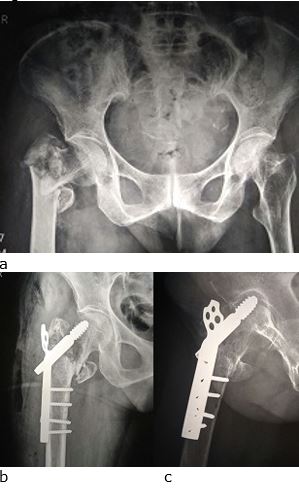Introduction
Hip fractures are common injuries in the elderly, which are one of the major public health concerns leading to loss of function and prolonged disability [1]. Many patients never return to their pre-fracture activity level [2]. Non-operative treatment of an intertrochanteric (IT) fracture is rare nowadays and is used only in medically unfit patients, which may leads to coxa vara and shortening [3].
Early surgical fixation and mobilization are current recommendations for an optimal treatment of IT fracture patients [4]. Dynamic Hip screw (DHS) is the gold standard option available for stable trochanteric fractures [5,6]. But DHS has limited ability to prevent excessive sliding and medialization of the femoral shaft especially with unstable intertrochanteric fractures, which when treated has significantly higher reoperation rate when compared to those treated with Proximal Intramedullary nail (IMN) [7]. The use of IMNs is beneficial in treating unstable trochanteric femur fractures like comminution, loss of lateral buttress, reverse oblique fracture pattern and in osteoporotic patients [6-8]. But IMN is associated with higher complication rates, is technically demanding, which requires more expertise to do in comparison to DHS [9-10]. Further IMN does not confer any advantages in terms of outcome and leads to higher treatment costs [11].
The combination of trochanteric support plate (TSP) with DHS makes a biomechanically stable construction which allows reconstruction of the lateral wall to maintain adequate lever arm and avoids femoral shaft medialization associated with DHS alone [12-13]. Thus we evaluated the role of the combination of trochanteric support plate (TSP) with DHS in management of unstable trochanteric fractures.
Materials and Methods
This prospective study was conducted during October 2015 to September 2017 on 25 patients of unstable intertrochanteric (IT) fractures presenting at our center, after obtaining approval from the institutional ethics committee. Out of these 25 patients, 2 patients died during follow up and 2 were lost to follow up, thus only 21 patients, who completed minimum follow up period for 6 months constituted the cohort.
Patients presenting with unstable trochanteric fractures with age more than 18 years were included in the study whereas patients with an open fracture, with previous history of hip surgery, with multiple fractures of the ipsi-lateral limb or pathological fracture were excluded from study. AO / OTA A1, A2 and A3 fractures with broken lateral wall cortex or lateral wall thickness < 2.24 cm as measured on X rays were graded as Unstable fractures and included for the study [14-18].
After obtained medical clearance, all patients were operated under the same spinal anesthesia on fracture table. Direct lateral approach to hip was used, same as that for DHS fixation with incision extending proximally 3-4 cm more, to negotiate the spoon-like part of the TSP on the DHS, to buttress it on to the lateral aspect of the greater trochanter.
Firstly, guidewire insertion was done in the centro-inferior and center part of head of the femur in the anteroposterior and lateral fluoroscopic image, respectively. This was followed by insertion of appropriate size lag screw after triple reaming and then finally DHS with TSP barrel plate was coupled on lag screw. The spoon-like part of TSP was bent to fit the contours of the proximal femur. Additional cancellous screws or encirclage wire were applied through the TSP part in some cases for additional stability as per surgeon’s discretion.
Postoperatively, all patients started with static quadriceps exercise immediately. Ambulation with non-weight bearing was started on the third postoperative day and progressed to partial weight bearing as soon as possible depending on the quality of bone, stability of biomechanical construction and tolerance of the patient. Patients were followed-up regularly at 1 month, 4 months, 6 months and 1 year postoperatively.
Outcome was assessed for blood loss, intraoperative and postoperatively for functional outcome and Union. Intraoperative blood loss was assessed by number of mops used and blood collected in suction [19]. Functional assessment was done as per harris hip score and Kyle's Criteria [20]. Fracture was said to be united clinically, when there was no pain and tenderness at the fracture site and the patient was able to bear full weight without any pain and radiological, when there was no fracture line visible on rays and there was presence of bridging callus across at least three cortices [21]. Statistical analysis was done by Fischer test and Chi-square test. Results were considered significant at p-value < 0.05.
Results
21 patients with mean age of 67.14 years (range 45 to 86 years) and male preponderance (Male: Female ratio 4:3) were included in study. Two-third of the patients had left side involved. Fall while walking was most common cause of injury seen in 90% of cases, whereas 4.8% was due to RTA and 4.7% due to fall from height. As per AO subtypes, A1.3, A2.1, A2.2, A3.1 and A3.2 were seen in 2,6,4, 4 and 5 cases respectively. There were 10 cases (47.6%) with intact lateral wall and 11 cases (52.4%) with loss of lateral wall integrity. The mean delay in surgery from date of injury was 15.7 days (range 5 to 35 days).
The mean duration of surgery and blood loss was 100.5 minutes and 312 ml, respectively, which was found to be statistically significantly for both with p-value < 0.05 as found by Fisher exact statistical test. 2 out of 21 cases (9.5%) were found to have superficial infection, which healed with extended antibiotics.
Mean TAD (Tip Apex Distance) was 13.5 mm (range 6 to 28mm). Neck screws were placed at centro-centro position in 42%, centro-posterio in 42%, inferio-centro, inferio-posterior and centro-anterior position in each 4.7% cases. In one patient (4.7%) screw cut out occurred as the position was superior-anterior. Mean Collapse of lag screw was 6 mm (range 4 to 20mm).




